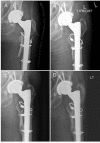Monoblock tapered stems in management of UCS B2 and B3 periprosthetic fractures in revision total hip arthroplasty
- PMID: 37524356
- PMCID: PMC10390262
- DOI: 10.1302/2633-1462.48.BJO-2022-0160.R1
Monoblock tapered stems in management of UCS B2 and B3 periprosthetic fractures in revision total hip arthroplasty
Abstract
Aims: United Classification System (UCS) B2 and B3 periprosthetic fractures in total hip arthroplasties (THAs) have been commonly managed with modular tapered stems. No study has evaluated the use of monoblock fluted tapered titanium stems for this indication. This study aimed to evaluate the effects of a monoblock stems on implant survivorship, postoperative outcomes, radiological outcomes, and osseointegration following treatment of THA UCS B2 and B3 periprosthetic fractures.
Methods: A retrospective review was conducted of all patients who underwent revision THA (rTHA) for periprosthetic UCS B2 and B3 periprosthetic fracture who received a single design monoblock fluted tapered titanium stem at two large, tertiary care, academic hospitals. A total of 72 patients met inclusion and exclusion criteria (68 UCS B2, and four UCS B3 fractures). Primary outcomes of interest were radiological stem subsidence (> 5 mm), radiological osseointegration, and fracture union. Sub-analysis was also done for 46 patients with minimum one-year follow-up.
Results: For the total cohort, stem osseointegration, fracture union, and stem subsidence were 98.6%, 98.6%, and 6.9%, respectively, at latest follow-up (mean follow-up 27.0 months (SD 22.4)). For patients with minimum one-year of follow-up, stem osseointegration, fracture union, and stem subsidence were 97.8%, 97.8%, and 6.5%, respectively.
Conclusion: Monoblock fluted stems can be an acceptable modality for the management of UCS B2 periprosthetic fractures in rTHAs due to high rates of stem osseointegration and survival, and the low rates of stem subsidence, and revision. Further research on the use of this stem for UCS B3 periprosthetic fractures is warranted to determine if the same conclusion can be made for this fracture pattern.
© 2023 Author(s) et al.
Conflict of interest statement
R. Schwarzkopf reports royalties from Smith & Nephew, consulting fees from Smith & Nephew, Zimmer, and Intellijoint, speaker payments from Smith & Nephew and Zimmer, leadership or fiduciary role on AAOS, AAHKS, Arthroplasty Today, and Journal of Arthroplasty, and stock or stock options in PSI, Gauss Surgical, and Intellijoint, all of which are unrelated to this study. D. T. Watson reports consulting fees and speaker payments from Smith & Nephew and Corin, unrelated to this study.
Figures



References
LinkOut - more resources
Full Text Sources
Miscellaneous

